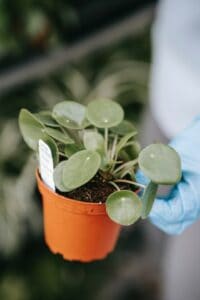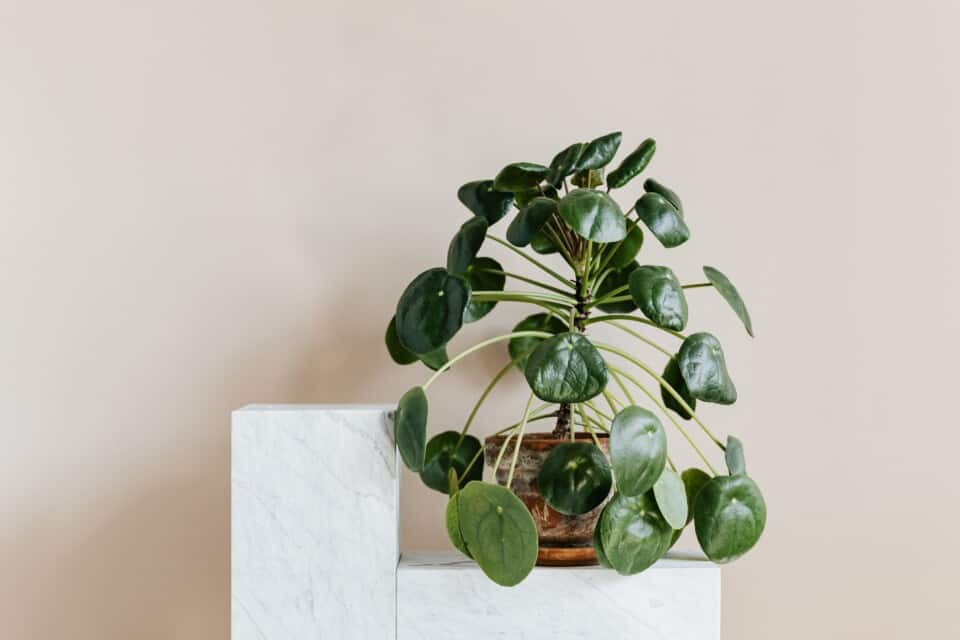Some links in the post are affiliate links and I get a commission from purchases made through some links found in the post.
My home is full of plants. Some are so tall that they almost touch the ceiling. I like using them as accent pieces rather than using art. And it works.
Others are short – much like accessories that complement the towering species. And anytime I want to move a plant to another section or add one to my home, I must consider where it fits best. So, how big can a Pilea get?
I’ll start by breaking down the Pilea. It’s not an actual plant – instead, it’s a genus that comprises more than 600 species.
So, when I describe the Pilea, I am talking of the general genus but not a specific plant. Such a plant should grow 12 inches tall at maturity (about 30 centimeters). The most common pilea being the pilea Peperomioides grows to a height of 12 inches (30 centimeters).
Its foliage which is pretty round and large, reaches about 3 inches. Thus, I consider the Pilea an accessory to my tall species.
But, of course, not every Pilea reaches 12 inches. And some even go beyond the 12 inches. This guide covers how big your plant can get, how to ensure it becomes big, and what to do when its growth gets out of control.
How Big Can a Pilea Get?
 Pilea is a genus with hundreds of species tied to it. And it comprises both trailing and bushy species. The smaller species are what you find in homes as they grow to average heights of a few inches.
Pilea is a genus with hundreds of species tied to it. And it comprises both trailing and bushy species. The smaller species are what you find in homes as they grow to average heights of a few inches.
They grow fast and soon hit about 12 inches at maturity, with foliage averaging 3 inches. But again, this comes down to the type of species you grow in your home. Examples include:
- Pilea mollis ‘Moon Valley’,
- Pilea microphylla,
- A Pilea nummulariifolia,
- Pilea peperomioides, and
- Pilea cadierei.
Take the Pilea nummulariifolia as an example. While most Pilea species would reach a few inches and stop growing, this species can spread quite fast, more so when grown outdoors where it can trail as it wishes.
Gardeners also refer to it as the Creeping Charlie, and anyone who has dealt with it can tell you that it can soon become a nuisance.
And when you consider the Pilea Peperomioides, this plant can grow as tall as 25 inches with a width of 30 inches! And that is almost twice or thrice the general Pilea statistic.
Thus, there is no given standard of how big a Pilea can get as it depends on the type of species you have. But in an indoor setting, 12 inches should be a reasonable estimate.
How Fast Do Pileas Grow?
Pileas grow fast when given their basic care requirements. If they do not lack water, light, and nutrients, they can double in size each year.
That means that if your Pilea is 4 inches now, it could be 8 inches in the next year. You can encourage the plant to grow even faster by repotting it every 1 to 1.5 years and feeding it twice yearly.
When repotting the plant, you should use a pot an inch or two wider than the current pot.
How Do You Grow a Pilea Bigger?
Assuming you want your Pilea to be much taller and broader than the usual 12 inches. What can you do to trigger such growth?
Well, plants thrive when afforded their basic care requirements. And for the Pilea, which is a great starter plant, this should not be hard. Your plant will grow big if it has:
1) Adequate Light
This plant prefers bright and indirect light. As such, you should place it next to an east or west-facing window where it can enjoy afternoon or morning sun.
When placed in direct sun, the leaves burn due to the heat from the sun’s rays, which negatively affects photosynthesis.
And when you place the plant in low light conditions, it starts showing leggy growth accompanied by small and yellowing leaves.
It does this to reach the light to make food to enable it to develop foliage. If your plant does not have access to adequate light, you should invest in grow lights to supplement what you cannot get in your home.
For more information on pilea and light, we have a full pilea light guide to answer all your questions.
PS: All Pileas tend to be leggy even in the presence of adequate bright and indirect light. If you want the plant to be bushy, you need to pinch off the tips of new growth on the branching Pileas.
Note, though, that as the plant ages, the leggy growth will become even more pronounced due to the loss of leaves on the lower side of the plant. In this case, you can always propagate a new plant and start afresh.
We have an article on how to fix a leggy pilea & how to prevent it in the future.
2) A Good Potting Mix
 Pileas growing outdoors rarely need much in the way of soil amendment. But when growing a Pilea in a pot, you must ensure that it has access to well-draining soil.
Pileas growing outdoors rarely need much in the way of soil amendment. But when growing a Pilea in a pot, you must ensure that it has access to well-draining soil.
Otherwise, the soil can hold on to too much moisture, encouraging root rot that could kill the plant. You should use a peat moss-based potting mix for your Pilea.
Also, ensure that the pot has adequate drainage holes to avoid water retention.
3) A Flexible Watering Schedule
The Pilea has succulent properties that enable it to hold on to water for long periods. As such, you should only water it when the top two inches of the soil are dry.
Overwatering causes waterlogging, which poses a threat to the plant. Moreover, underwatering is also harmful as it reduces cellular activities and causes the plant to droop.
If your pilea is drooping we have an article that can help you.
To maintain a good watering schedule, you can invest in a moisture meter to help you know when the plant needs some water.
4) Regulated Temperature
The Pilea does well in temperatures between 65- and 95-degrees Fahrenheit. It can survive in lower temperatures as long as they do not fall below 50 degrees, as this can kill the plant.
Also, note that the plant does not appreciate sudden temperature changes. You should thus position it away from any hot or cool air vents.
The plant enjoys moderate to high humidity. You do not need to alter the humidity unless you live in an area where the levels are exceptionally low.
In such a case, you can improve the humidity levels by installing a humidifier or opening the doors to the kitchen and bathroom.
For more information on humidity, we have created an article on what is the ideal humidity for a pilea.
5) Adequate Nutrients
Indoor plants do not have access to nutrients save for those in the potting mix. And when the Pilea depletes what is in the soil, it has nowhere else to source its nutrients.
To account for this, you should feed it twice a year using a liquid houseplant fertilizer diluted to half its strength. You should do this in the summer and the spring when the plant is actively growing.
If you can provide your Pilea with the above requirements, it should grow quickly. Please note that the Pilea grows actively in the spring and summer months.
But in the cold months, its growth slows. It’s thus best to repot the plant in the spring when it’s actively growing as this helps it withstand and move past transplant shock.
To prevent it from becoming rootbound, you should repot the plant in a bigger pot at least every 1 to 1.5 years. And in cases of prolific growth, you may need to repot the plant more often than this.
What Do You Do When Pilea Gets Too Big?
If your Pilea has exceeded the usual 12-inch stats, you’ve done a great job giving it what it needs.
But if you are reading this, you probably want a way to curb the plant’s growth before it takes over your home. Or want a way to support its growth. Here are the options available to you:
Supporting the Pilea
If the plant looks unstable, you can stake it. However, this is not a sustainable solution as you will need to keep staking the plant as it grows.
After all, you have not dealt with the underlying cause of the robust growth.
Trimming the Pilea
While this is not a common approach, you can cut back on the Pilea. To do this, you can remove the shoots from the ground, allowing your stem to get adequate access to light.
Again, this will not work long-term because you will need to keep trimming the plant.
Cutting the Pilea

If you do not want to keep trimming the plant, the answer is to cut the Pilea in two! In doing this, you end up with two plants.
The lower part of the plant starts branching out and grows like a bush. You can then root the top part of the plant to give rise to yet another Pilea.
When doing this, remove most of the foliage and leave the stem in water for a few weeks until the roots show. You can then transfer the plant to a pot and grow a Pilea.
How can you keep your Pilea from growing too big? Easy – you avoid repotting it until you need to do so.
If the plant does not have room to grow, it will not grow to uncontrollable sizes. However, in about 1.5 years, you have no option but to give it a bigger pot.
Final Thoughts
The Pilea is one of the easiest plants to grow in the home, regardless of whether you go for the bushy or trailing species.
Give it enough water, nutrients, and light, and it will soon reach heights that will beautify your space. And if it becomes too big, you now know what you can do – Happy Gardening!
Related articles:

